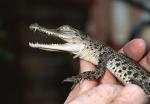Crocodile evolution no heart-warmer
 Environmental Biology Environmental Biology
It's strange to imagine ancestors of the crocodiles we know today as smaller, faster, land-based creatures that could run on two legs, but a University of Adelaide researcher has got to the heart of the matter. Professor Roger Seymour from the Discipline of Environmental Biology says the modern crocodile heart is evidence that they were originally warm-blooded creatures that evolved into cold-blooded ones - an assertion which turns conventional evolutionary theory on its head. "There's an assumption that warm-bloodedness always evolves from cold-bloodedness, because being warm-blooded is seen as better - this is a reversal of that thinking," he said. "The strongest clue comes from the four chambered heart that living crocodiles share with birds and mammals. Such a heart perfectly separates blood going to the lungs from that going to the body, which is a requirement for the high blood flow rates and high metabolic rates characteristic of warm-bloodedness. However, living crocodiles are cold-blooded, so it didn't make sense for them to have a warm-blooded heart. Professor Seymour's work on the development of salt-water crocodile hearts and that by Christina Bennett-Stamper on American alligators shows that the embryos go through stages that indicate their evolutionary history. Their little hearts start out with the potential ability to separate blood flow to the lungs and body, but much later develop the curious features of the adult crocodile. Adult hearts are extremely complicated, as unlike birds and mammals which have one aorta, the crocodile has two, and they are twisted so that the left aorta attaches to the right ventricle and the right aorta attaches to the left ventricle. They also have a unique "cog-tooth" valve and a hole between the aortas. "It turns out that all of these advanced cardiovascular features are valuable for today's crocodiles, enabling them to bypass the lungs and hold their breath for longer periods," Professor Seymour said. "Crocodiles typically remain hidden under water until their prey comes near, then they lunge and often drown their victims. Warm-bloodedness is not suited for this type of sit-and-wait hunting, because of a high metabolic rate and a need to breathe often. "When I looked at the palaeontology of crocodiles, a consistent picture appeared-the earliest ancestors of crocodiles were definitely not sit-and-wait predators. Instead, many had long legs and some ran around on only two legs. These were obviously highly active, terrestrial predators which would have been well served by warm-bloodedness and a four chambered heart. "Between 200 and 65 million years ago, the crocodilian lineage diversified into more than 150 genera in all kinds of habitats from land-based to fresh water and the ocean," he said. "Only one relatively small group that were aquatic and sat and waited for food to come to them managed to survive until today. All the rest became extinct about 65 million years ago with the big extinction when most of the dinosaurs died out," he said. "The cold-bloodedness that this group evolved may have been a factor that saved it." Professor Seymour said the earliest crocodiles were among a group of animals known as archosaurs which evolved on one lineage into dinosaurs which in turn gave rise to birds, and on a separate lineage into the present crocodiles. "There is a long-standing question about whether dinosaurs were warm or cold-blooded and where a change may have occurred, but our work has shown that even their ancestors were highly active, warm-blooded animals." Story by Lisa Toole
|






